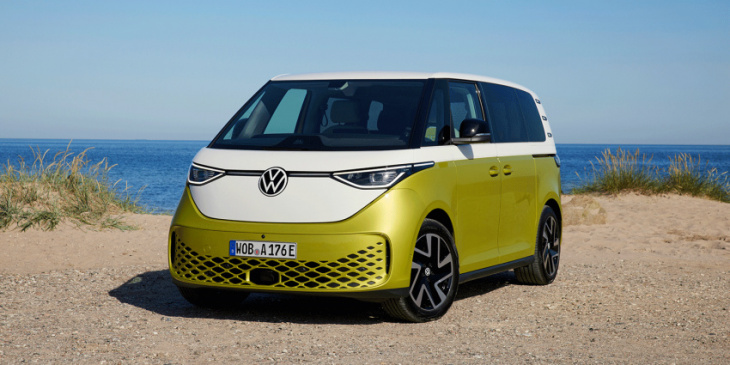
When still in office, Volkswagen boss Herbert Diess described the ID. Buzz as one of the most exciting vehicles launching this year. Our first drive of VW’s electric van shows that the carmaker has indeed succeeded in creating a great electric car that goes down very well with passers-by. If only it weren’t for the price.
* * *
Whether you know about cars or not, you’ll recognise any VW bus in its iconic two-tone livery. So it’s hardly surprising that the ID. Buzz attracts attention – always in a positive sense. Passers-by whip out their smartphones to take a quick photo during the test drive in and around Copenhagen. On the motorway around the Danish capital, many other drivers also look over closely and sometimes give thumbs up.
Still, that’s fairly new. The initial reactions to the series model and the last prototypes in rainbow disguise were more divided. The front design saw the most critique: when Volkswagen presented the eponymous study of the ID. Buzz, in January 2017, the front was clean-cut. The large windscreen merged with the white-yellow sheet metal in a curved line, as it were. There was nothing to detract from the study’s retro look.
However, the series van unveiled in March has a kind of snub nose: the windscreen opens out at the bottom into a small front superstructure reminiscent of an engine bonnet of a convention gas guzzler. The decision was discussed at length internally, as VW representatives told electrive on the sidelines of the presentation. But in the end, the matter was straightforward: the production model needs the space for the installation of the optional all-wheel drive, for example, and the air-con compressor and things like the windscreen wipers have to be accommodated there. And the front body must also provide the necessary crash safety – all things designers don’t have to consider in a study.
ID. Buzz is based on a car platform – and you feel it.
But we didn’t travel to the Danish capital to discuss design issues but to drive the ID. Buzz. And after just a few metres, it becomes clear what sets this electric van apart from many others in his class: The ID. Buzz is not based on a commercial vehicle platform that also accommodates petrol and diesel engines but on a passenger car platform that has been purely electric from the start. Of course, the seating position in the VW bus is elevated, but the ergonomics are much closer to a large SUV than a commercial vehicle. Only the visibility with the large all-around window is significantly better than in an SUV of the same size or class.
At the market launch, the drive system was only available in the ‘Pro’ version known from the ID.4: the electric motor on the rear axle has an output of 150 kW, and the battery placed in the underbody between the axles has a usable energy content of 77 kWh but uses cells from a different supplier despite the same data. This means that the ID. Buzz can travel up to 423 kilometres (WLTP) or reach a maximum speed of 145 km/h.
Later, VW will add a smaller battery version, which, according to brand representatives, will hardly be relevant for the passenger car but aims at cargo vehicles (more on this in a moment). Private customers are more flexible than delivery services and want more range. However, VW will offer a larger battery only in the upcoming long-wheelbase van, for which they have retooled the Hanover plant during the summer break. VW does not want to give exact data on the extended version yet, only this much: the model will be around 25 centimetres longer, bringing the vehicle from the current 4.71 to about 4.96 metres. However, the front and rear overhangs remain the same for design reasons, and the extra centimetres are entirely taken up by the wheelbase (2.99 metres to around 3.25 metres), which creates space for a more extended sliding door but also a larger battery.
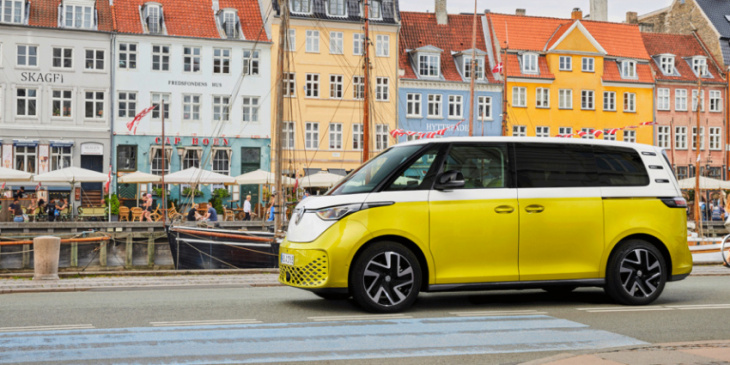

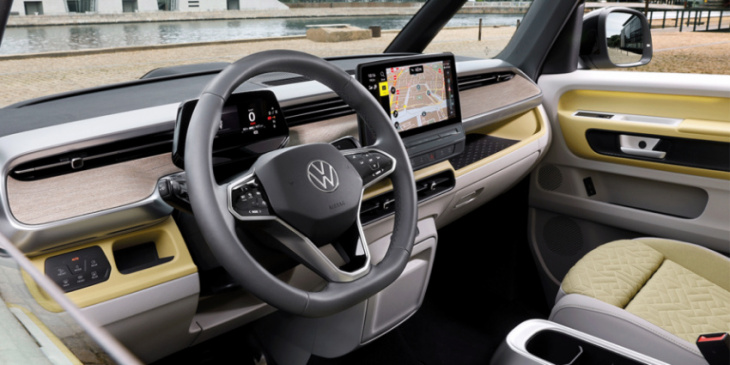
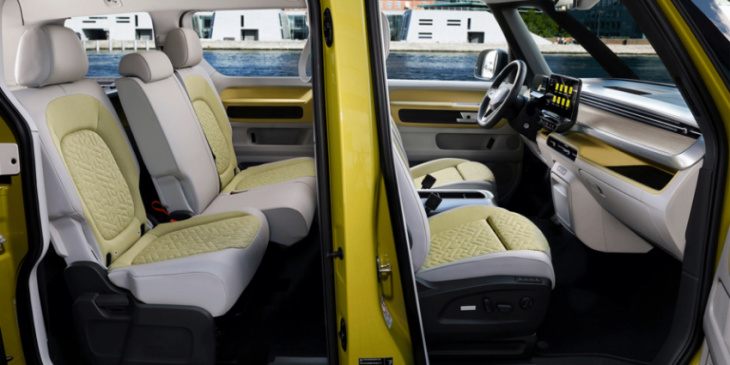

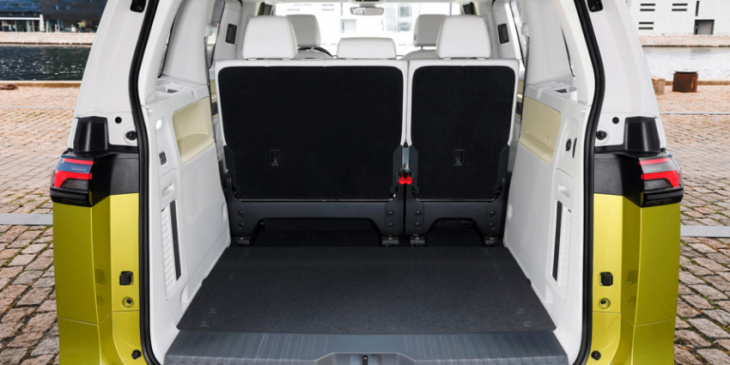
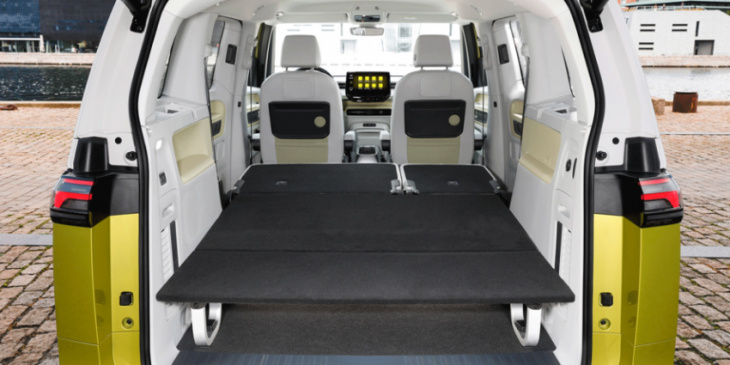

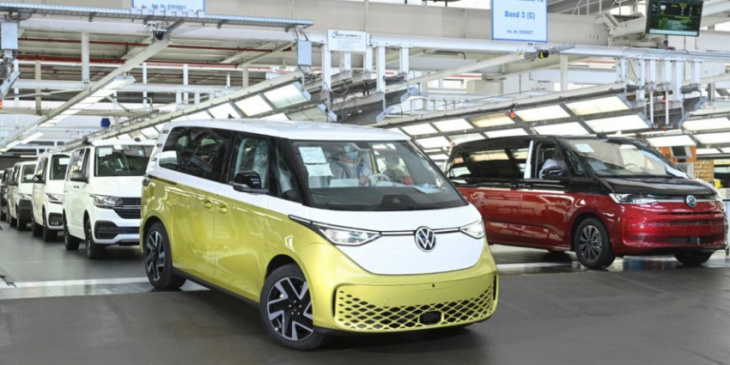
Perhaps the wheelbase beyond three metres will give it more of a van-like driving feel because the “short” ID. Buzz basically drives as unagitated as a similarly sized passenger car. The ride comfort is good, and the steering is smooth but precise enough. In the version currently only available as a five-seater, no rumbling or creaking can be heard on bumps or utility hole covers. Only on the motorway you notice the slightly higher wind noise, compared to sitting in an ID.4. With a cW value of 0.285 and its large frontal area, the ID. Buzz has to push aside quite a bit of air.
Concerning its aerodynamic drag, however, consumption was surprisingly low during this first drive. After about 140 kilometres through Copenhagen, across the Öresund Bridge to Sweden and back to Roskilde in Denmark, the onboard computer showed 18.6 kWh/100km. Two factors favoured this good consumption value: The temperatures were optimal in an EV-sense at around 23 degrees, and the speed limit on the motorway did not allow more than 110 km/h. How high the actual consumption is on the highway at 130 km/h or even close to the maximum speed of 145 km/h will probably only be revealed by a detailed test in Germany. The assumption is based on experience with other electric vans: every km/h more will hurt. The only question is how much.
If you calculate with a consumption of 22 kWh/100km, you still have a range of 350 kilometres. At 25 kWh/100km, it would still be 308 kilometres. It will also be interesting to see how consumption reacts to much lower temperatures in winter. The van’s interior has a significantly larger volume than, say, the ID.4, all air that has to be gradually warmed up during long-distance winter drives.
DC charging at 170 kW peak
In a detailed test, we also closely examine the charging performance. With a peak of 170 kW, VW promises a charging time of about 30 minutes, from five to 80 per cent. This corresponds to an average of 116 kW. After the first 140 kilometres (the battery was at 100 per cent when we left), there was still 68 per cent or, according to the onboard computer, power for 295 kilometres in the battery. Our test consumption of 18.6 kWh/100km would result in a calculated range of 413 kilometres. In this respect, the 295 kilometres at 68 per cent charge seem pretty realistic.
VW equipped the white and yellow test vehicle with almost all functions on the extras list. These included the full range of driving assistance systems of the new version 3.0, i.e., the Travel Assist with swarm data. A somewhat unwieldy name, but in the end, the system uses the data of other vehicles from the cloud, made available via V2X communication. For example, swarm data makes enables Travel Assist to provide support on roads with only one lane marking; impossible otherwise using the sensors in the vehicle alone. In addition, the system can keep the car centred in its lane and swerve to the left and right.
During the motorway test drive, the most impressive function was the lane change, for which the system relies on two radars in the rear and ultrasonic sensors. From 90 km/h, the vehicle virtually changes the lane by itself; the driver only has to monitor the surroundings and keep his hands on the steering wheel since the capacitive sensors otherwise abort the process. Other vehicles can now also change lanes automatically, but changing lanes often takes an extremely long time, so in everyday life, you tend to do it yourself. Not so in the ID. Buzz, where the system changed lanes so quickly and confidently that, after the first tests, you can at least imagine using the function more often.
Practical interior with lots of hard plastic
Another new feature of the 3.0 software is Park Assist Plus with a so-called memory function. The vehicle can learn up to five parking manoeuvres. The driver has to park once himself and save the process. Subsequently, the car can repeat the manoeuvre on its own, for example, in driveways or parking in the garage. The driver then only has to monitor the manoeuvres, which can be up to 50 metres long.
Once the ID. Buzz is parked, there is time to take a look around the interior. Much is familiar about the MEB technology, but with a few changes here and there. The driving modes are no longer selected via a rotary control directly on the cockpit display but via a separate, lower-positioned steering column lever. The central infotainment touchscreen is familiar, but the air outlets and storage compartments have, of course, been repositioned in the van cockpit. One positive feature is the inductive charging cradle for smartphones, located in the dashboard between the steering wheel and the central touchscreen. When getting into the car, you can put down your smartphone with a flick of the wrist without first having to open a compartment in the centre console. When getting out of the car, the device is also within easy reach, yet it is out of sight while driving. Criticism: Apart from the lightly padded armrests in the doors, the cockpit is made almost entirely of hard plastic, as in the other MEB models.
On the other hand, the interior is entirely free of animal leather. The front seats come with a folding armrest on the inside; the second one on the outside is optional. Currently, the ID. Buzz in the second row only with the sliding three-seat bench. Later, there will be a six-seater in the short version with single seats in the back. Volkswagen will only offer the upcoming extended version as a five-, six- and seven-seater and will not put the eight-seater announced in the 2017-study into series production.
In the passenger car version, the boot holds between 1,121 litres (five-seater with window-high loading) and 2,132 litres. As part of the ‘Comfort’ package, VW also offers a so-called Multiflexboard with two folding boxes. This is a kind of double floor for the luggage compartment, which is anchored in two parts in the seat rails (for seats 5 and 6 in the six-seater). The folding boxes can then be used to stow the charging cables, for example.
The ID. Buzz does not have a frunk – the front flap opens only to refill the wiper fluid. The developers made this decision on purpose: a frunk would have made the car front even longer. These centimetres would then have been missing further back in the actual passenger compartment. They also decided against a fixed case for the charging cable – there is the option of a double bottom and folding boxes, but it is not a must. The customer should have the choice of how to use the interior. Hence the optional double floor. If VW had installed it permanently, the loading height would have been lower.
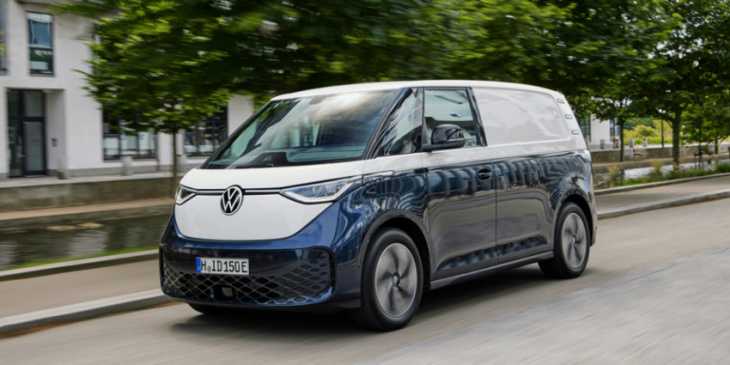
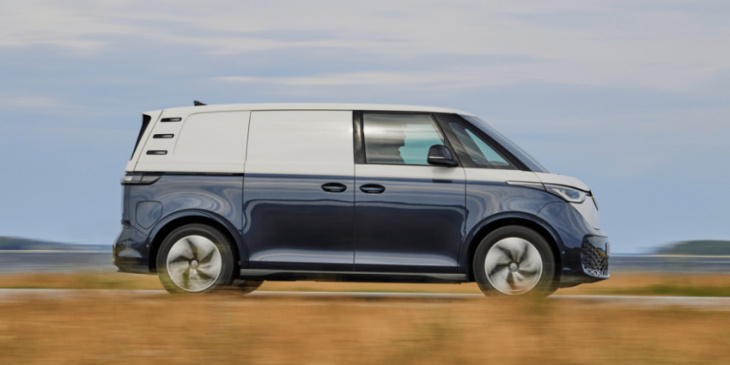
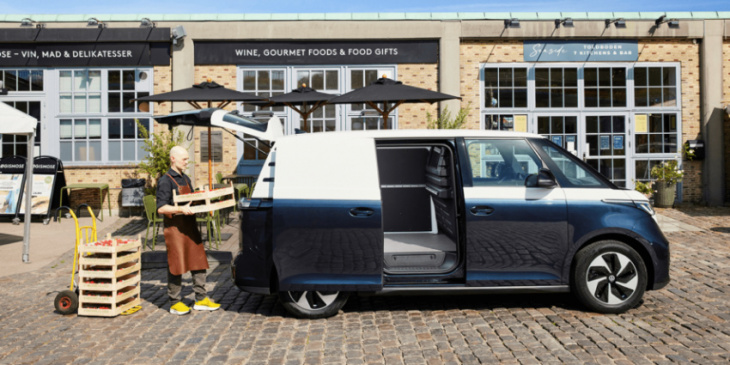


All the cargo space, flexibility, comfort and chic yet modern retro look described above are, however, come at a well-set price. As reported, the base price for the five-seater is 64,581 euros. With a few extras, the ID. Buzz can be configured to cost more than 76,000 euros. Our test car was not fully equipped; it stood on 20-inch rims; 21-inch rims are also available. Even the VW Multivan is no longer an affordable car, but the ID. Buzz, however, goes beyond. The electric van will likely exceed the budget of most family cars. On the one hand, the ID. Buzz is very expensive, but the price is not exaggerated in the market environment. Even an Opel Zafira-e Life with the 75 kWh battery and equipment can be brought to a gross list price of 75,000 euros, a model that is based on a commercial vehicle.
From one of the most expensive IDs. Buzz, we switched to one of the cheapest versions at the Copenhagen event: the ID. Buzz Cargo in almost basic equipment (from €45,740 net). VW gave the test car the two-tone paint job (this time in white-grey), but otherwise, they saved money. The car stood on the standard 18-inch steel rims with hubcaps. In the cockpit, three-person bench seats were installed instead of the two single chairs. The dashboard also has a different design, and the storage compartments divide differently. There are plenty of charging options for smartphones or other devices. In contrast to the passenger car version, it is clear that hard plastic dominates here, but even the armrest in the door no longer has any upholstery.
ID. Buzz Cargo offers loads of space but not much payload.
The Cargo does not come with side windows at the rear but with sheet steel. Nevertheless, the visibility remains quite reasonable since the window in the partition wall to the load compartment is very large, and thus (depending on the load, of course), the view through the interior mirror remains possible. The cargo compartment itself holds 3.9 cubic metres. Access is via the tailgate or the sliding door on the right; a second sliding door on the driver’s side is optional.
We drove the Cargo mainly through the city and suburbs of Copenhagen and a little bit on the city motorway at 90 km/h. The car’s speed was about 60 kilometres. After about 60 kilometres, the consumption was only just over 15 kWh/100km, and at 77 per cent, according to the onboard computer, a range of 360 kilometres was still possible. But the big problem was that the payload during the test drive consisted of only two umbrellas, so the hold was empty. Nevertheless, it is clear why VW is positioning the cargo model with a smaller battery: If a parcel delivery driver travels less than 150 kilometres on his daily route, he will not need the large and expensive battery, even when carrying cargo.
For delivery services (the ID Buzz Cargo fits up to two Euro pallets), the maximum payload of 650 kilos may be sufficient because the volume is often the limiting factor for parcels. However, a tradesman’s extension with heavy-duty shelving, tools and spare parts is likely to push the Cargo to its limits quickly.
Both the ID. Buzz, as well as the ID. Buzz Cargo can tow a maximum of one tonne with the optional, partially electric trailer coupling. Analogous to the other ID. models, the upcoming all-wheel-drive vehicles may be allowed to tow up to 1.4 tonnes. Compared to today’s use of some Multivans, Californias and vans, however, this is little – too little, depending on the application.
Conclusion ID. Buzz drive review
The expectations for the ID. Buzz was high, and VW delivered. Overall, the result is convincing, some compromises had to be made on the way to the production model. As a spacious and comfortable family van, the ID. Buzz gets the most out of the MEB platform and will make many customers happy. But even Volkswagen cannot push the limits of what is technically feasible. The ID. Buzz is not a 1:1 replacement for a combustion engine van of the same size. In terms of payload and towing capacity, it cannot quite meet the requirements of some commercial users and private customers. Taking a caravan to Italy, a horse trailer to the next tournament, or a surfboard on the roof to Portugal will probably be much more complex with an electric van than with the diesel – or is just not yet possible. But if you take the long haul with the same ambition as the original Bulli, the journey is the destination anyway.
>> ID. Buzz first drive review by Sebastian Schaal, Germany.
Keyword: VW ID. Buzz: First drive in Volkswagen’s electric Bulli
